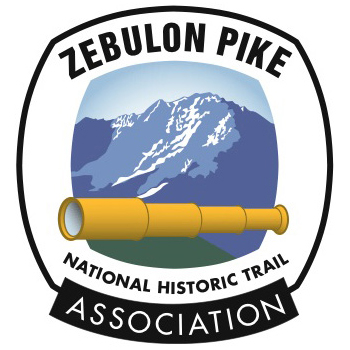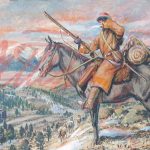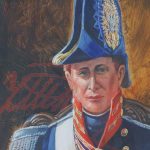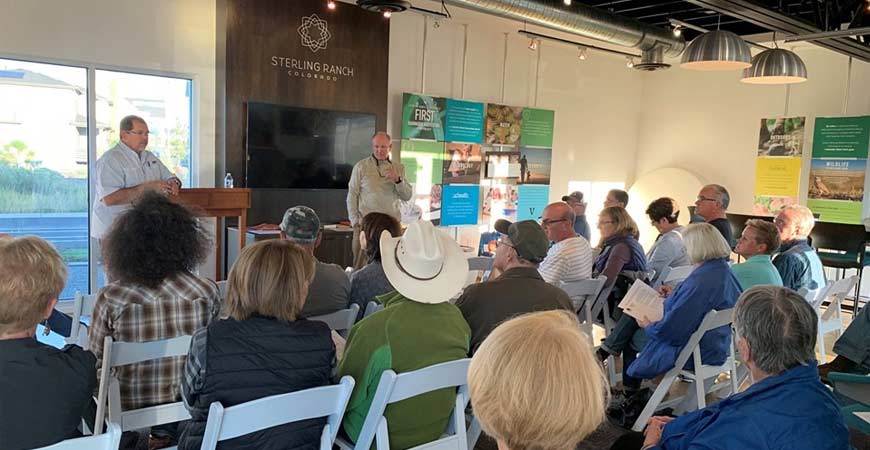Brigadier General Zebulon Montgomery Pike and Pikes Peak
On October 2, 2019, Brian and Cliff Pike gave the following presentation on Brigadier General Zebulon Montgomery Pike, to a group of over 20, at Sterling Ranch in Littleton, CO.
“Good evening, and thank you for inviting us to share some of the history of our Uncle, General Zebulon Montgomery Pike. I am Brian Pike, and my cousin, Cliff Pike, serve on the Board of the Pike National Historic Trail Association. We aim to provide some lesser known facts of the accomplishments, and some of the characters involved, of this of American soldier.
While General Pike is, undoubtedly, one of the heroes in Americas early history, his achievements are somewhat obscure. His life was one of service and loyalty to America, including two significant Expeditions; one to the headwaters of the Mississippi River in 1805, and one to the America’s Southwest, that included Colorado, in 1806. These epic adventures, originating from Fort Bellefontaine, near St. Louis, played an important role American history, providing valuable information on major waterways, interaction with Native Americans, exploration of the Louisiana Purchase, and reconnaissance of the Spanish Army along our Southern border. Pike would rise to the rank of Brigadier General before being killed in Battle at Fort York, at the age of 34.
Born near Lamberton, (today’s Lamington), New Jersey in on January 5, 1779, during the Revolutionary War, the son of an Army Officer. In 1801 he married Clarissa Brown and they had only one child who survived, a daughter named Clarissa Brown Pike, who would go on to marry President William Harrison‘s son, John. Pike’s infant son died during his Southwest Expedition. The name Zebulon Montgomery Pike was passed down our family line and my Grandfather, Uncle and cousin all are named after the great explorer.
His father, also named Zebulon, was a Colonel in General Washington’s Army during the Revolution and served in General Anthony Wayne’s Legion of the United States. You may remember General Wayne, whose claim to fame was leading a successful attack on British fortifications in Stony Point, NY where his bold tactics and bravery earned him the nickname “Mad Anthony.” General Wayne also thwarted British plans for the capture of West Point. Plans provided to the British by the traitorous Benedict Arnold.
Zeb, Sr. was known for his bravery as an Officer and in dealings with the Native Americans, in fact, he was called “The Great Brave” by the Native Americans. In a 1928 Magazine Article it stated; “He always visited their wigwams without any fear in making his treaties with their tribes.” Zeb Jr. would emulate the bravery of his father throughout his military career which began in 1794, at the age of 15, when he joined his father’s regiment as a cadet.
Pike’s early duties were along the Ohio frontier and consisted of supervising the transportation and distribution of supplies to Americas frontier posts brought west on the Ohio River.
He was quickly promoted to Lieutenant and in 1805 he was assigned to lead an expedition to the headwaters of the Mississippi followed by the Southwest expedition.
Zebulon Montgomery Pike’s 1st Expedition – Up the Mississippi
The commanding general of Jefferson’s U.S. Army, General Wilkinson, one of American history’s worst scoundrels, was secretly a double agent for Spain. We’ll talk more about Wilkinson later. Anyway, In the summer of 1805, Wilkinson gave Pike the difficult assignment of conducting a reconnaissance of the upper Mississippi River. While Lewis and Clark were at the headwaters of the Missouri River far to the West, Pike left St. Louis with orders to explore the Mississippi, survey and purchase sites from the Natives for future military posts, bring a few important chiefs back to St. Louis for talks, and confront the British for their violations of treaty and international protocol associated with the Louisiana Purchase. He took a force of twenty men on a seventy-foot keelboat up the Mississippi, departing from Fort Bellefontaine (Cantonment) on August 9, 1805. Pike and his men explored the river into modern-day Minnesota, traveling to Cass Lake, which they identified as the river’s source. The expedition returned to St. Louis on April 30, 1806. Pike brought back important geographical information about a little-known portion of the new Louisiana Territory. However, his belief of the headwaters being Cass Lake was incorrect, it is actually Lake Itasca, a smaller lake approximately 14 miles to the Southwest of Cass Lake.
Zebulon Montgomery Pike’s 2nd Expedition – Southwest To Colorado
Shortly after his return he was sent on his second and most famous expedition, the Southwest in 1806. During the Southwest Expedition: They travelled 3,664 miles through 7 of today’s states and 3 Mexican provinces in 353 days. Remarkable considering much of it was on foot and in blizzard conditions.
It was designed to accomplish several goals including; providing an escort for fifty-one Osage Native Americans ransomed from the Potawatomi tribe, returning a delegation of Pawnees, Osages, and Otos from a trip to see President Jefferson, negotiating a peace between the Kansas and Osage tribes, and attempt to make contact with the Comanche people on the high plains. Pike was also to explore the headwaters of the Arkansas River, then to proceed south, locate the source of the Red River, and descend it to the Mississippi. The lesser known, and even secret goal was gaining information on the Spanish and their strength along the southern border.
As with Lewis and Clark further north, Pike was to closely study and report on natural resources and subjects of scientific interest, as well as the Native inhabitants along the poorly defined southwestern border of the Louisiana Purchase. Pike brought along nearly all the soldiers from his Mississippi expedition, men he called a “Dam’d set of Rascals, but capable of getting the job done” as they were a tough bunch, but had earned the confidence of Pike.
Not only were the headwaters of the Arkansas River found, the headwaters of the Osage, Cottonwood and South Platte rivers were also explored. Pike’s collection and mapping information earned him the title “The Father of the Santa Fe Trail.”
The young officer became known as a brilliant leader and well-respected statesman. As an example, when Pike was in in southern Nebraska, he convinced the Republican Pawnees into replacing a Spanish flag flying above their village with the Stars and Stripes as it was now on American soil. This was accomplished despite Spanish cavalry of over 300 men roaming the area. Can you imagine? Pike’s ‘force’ was 23 strong, yet he persuaded the Pawnees to replace the Spanish flag with the American flag.
On November 11, 1806, facing the intimidating Rocky Mountains and despite the fact that his party did not have the clothing, equipment or supplies for a winter expedition, they would press on. Proceeding nearly due west, they reached the site of modern-day Pueblo on November 23.
Fascinated with a blue peak, he called the ‘Blue Mountain’ that he had first sighted on November 15. Pike set out to explore the peak with two soldiers and a Doctor named Robinson, leaving the bulk of the men at a base camp in Pueblo. He spent several days in trying to reach the peak, but the lack of proper clothing and food, and harsh weather eventually drove him back to the base camp. While Pike never set foot on Pike’s Peak, the group scaled Mt. Rosa, becoming the first European-Americans to complete a high-altitude alpine ascent of a North American mountain. One of the stories tell of a cave containing a hot spring provided shelter and warmth, likely saving the young officer and his companions lives on their descent.
Determined to continue, Pike decided to follow the trail of the Spanish cavalry and head north up Four-Mile Creek from Cañon City and away from the Arkansas. This branch soon dwindled, as did the Spanish trail, so Pike turned overland due northward into South Park, discovering a river on December 12, which he correctly determined was the south and middle fork of the South Platte River.
Crossing over the mountains, he came to another river which he thought was the Red River. In reality, the expedition was back on the Arkansas, seventy miles upstream from where they had left it two weeks earlier. Snow began to deepen, and Pike was disappointed that he could not reach the source of the river. The men set up camp and spent Christmas, feasting on buffalo, near the city of Salida. Forging on they worked their way down the river, on ice solid enough to support their horses, with the huge vertical walls of the Royal Gorge towering above them on both sides.
Pike had come into Cañon City from the east, encountered the Royal Gorge to the west, and had explored to the north. Resolute to find the Red River, traveling now by foot south up Grape Creek into the Wet Mountain Valley. The interpreter, Vasquez, and Pvt. Patrick Smith were detailed to stay with the horses in a small wooden stockade built on the Arkansas, while Pike set out with the others on January 14, 1807, through howling blizzards, to find the Red River. Nine men soon suffered from frostbitten feet, including Pike’s best hunters. Determined they pressed on, wading through waist-deep snow. Suffering from frostbite and illness, three men had to be left behind. Crossing the Sangre de Cristo Mountains, Pike came upon the area of the Great Sand Dunes and the headwaters of the Rio Grande, which he mistakenly thought was the Red River. A small stockade was built near modern Alamosa, a replica of this Stockade stands near the actual site.
Dr. Robinson begged leave to contact the Spanish officials in Santa Fe, as he had a document which gave him authority to collect a debt there for a merchant in Illinois. Pike gave Dr. Robinson permission, and Robinson hiked overland to reach his objective, telling Spanish Governor of New Mexico, Joaquín Alencaster, that he had recently left a party of hunters. Suspicious, Alencaster reported the incident to his superiors and sent out patrols in the hope of apprehending some of the doctor’s companions. Meanwhile, Pike sent back two relief parties to bring up the three men left behind with frostbite, as well as the two left on the Arkansas with the horses. Only one of the three frostbite victims could be brought back; the others, too sick to move.
On February 16, 1807, Pike and a hunting companion were discovered by a pair of Spanish cavalrymen. On February 26, a troop of Spanish soldiers rode up to Pike’s stockade and informed him that he was in Spanish territory. Pike wrote “I immediately ordered my flag to be taken down and rolled up.” He agreed to accompany the Spanish to Santa Fe with his men and they departed the stockade two days later. Spanish patrols assisted with Pike’s frostbitten soldiers, and eventually escorted the rest of the party to Santa Fe. After being questioned about his mission by Governor Alencaster, Pike was sent south to Chihuahua to be examined by the Commandant General of the Internal Provinces, Nemesio Salcedo. Although Salcedo confiscated a number of Pike’s papers and notebooks, neither Pike nor his men were mistreated, and the majority were returned to U.S. territory at Natchitoches, Louisiana on July 1, 1807. Dr. Robinson claimed asylum in Mexico, but was not allowed to stay. Five of the men were held by the Spanish for two years, and one, Sgt. William Meek, was imprisoned until 1821 after killing another soldier in a drunken scuffle.
By sending Pike south to Chihuahua, Alencaster inadvertently gave Pike the opportunity to gather valuable intelligence about largely unknown regions of northern New Spain for the United States. Alencaster was reprimanded for doing so by Salcedo. Salcedo, in turn, was reprimanded by the King of Spain for releasing Pike before receiving an apology from the U.S. Government for trespassing. While in New Spain (now New Mexico, Mexico and Texas) nine fandangoes were enjoyed by Pike and his men and, remarkably, they were allowed to keep and carry their weapons. This was due to the respectful manner in which Pike treated the Spanish officers. Little did his friendly captors know that Pike had made detailed maps and information on the Spanish forts and armaments from Santa Fe to Chihuahua and concealed them by rolling them up and placing inside the barrels of his men’s rifles.
In 1810, Pike published an account of his expeditions, a book so popular that it was translated into Dutch, French, and German languages, for publication in Europe.
Pike’s final glory came when war was declared on Great Britain in 1812. As commanding officer he led a Regiment from Lake Champlain, in northwest New York, to ascertain the British strength in Montreal.
On April 27, 1813, while leading a successful attack on Fort York, today’s Toronto, Gen. Pike was fatally wounded when the retreating British blew up their powder magazine. He had just assisted a wounded solider and sat down to examine a captured British Sargent when hit by flying debris from the massive explosion. His men were furious their leader was killed and, as a result, looted the town of York and burned down their Parliament buildings, which enraged the British. It was reported by Pike’s officers that Gen. Pike would not have approved of the looting of York nor burning of the Parliament buildings. His body was brought back by ship and he was buried with military honors in Sackets Harbor, NY the home base of his operations and the largest naval shipyard on the Great Lakes.
You may remember from history class that British troops attacked Washington D.C. and set fire to the Capitol and White House on August 24, 1814. This was done in retaliation for the Americans’ burning of the Parliament Buildings at York, over a year prior.
Undoubtedly, both General Pike and his father were deeply involved in the early days of America, serving the country courageously in its fight for freedom and the hardships of exploring the unknown frontier.
Back to Wilkinson
General Wilkinson, who was Governor of Louisiana during this period, was ordered to engage in intelligence operations against Spain, using army officers disguised as traders if necessary. What he was really up to, however, has remained a mystery. It appears that, in collaboration with Vice President Aaron Burr (you may remember Burr famous for a duel where he shot his political rival, Alexander Hamilton, in 1804), Wilkinson and Burr were planning a coup in the West. It has never been determined whether this was a traitorous movement designed to separate the western territories from the Union, or a plot to conquer Spanish territory without officially involving the United States Government. At any rate, Pike’s expedition to the Spanish borderlands are suspicious on James Wilkinson’s part.
Reports show it was unlikely Pike knew of the Wilkinson/Burr maneuvers, but he was aware he was to gather as intelligence about the Spanish as a part of the mission. A letter between Pike and Wilkinson written on July 22, 1806, leaves little doubt that Pike knew he was to scout as close as possible to Santa Fe, and that he might be captured by Spanish authorities. Initially Pike was accused of involvement in the Burr and Wilkinson scheme to establish an empire in the Southwest, but investigation would prove Pike’s innocence. He was completely exonerated; however, this is likely the main reason the heroic life and times of General Pike is somewhat overlooked.
Throughout an amazing life, this superior and persistent leader performed extraordinary feats on behalf of his country. Unlike his contemporaries, Lewis and Clark, he is relatively obscure today, except for the use of his name on a mountain he actually never climbed.
Let me close with the words of President Thomas Jefferson who said; “Zebulon Pike was an American hero, a patriot who lived and died for his country.”
Allow me to turn the stage over to my cousin to share some additional information and then we’ll have time for a discussion and answer any questions, as long as there aren’t too difficult.
Pikes Peak
Before being officially recognized as Pikes Peak, the mountain had two names—Pikes Peak and James Peak—used interchangeably for almost forty years. Official approval came when US Army explorer John C. Frémont referred to the mountain as Pikes Peak in sketches on maps he published prior to the California Gold Rush.
Often called “America’s Mountain,” Pikes Peak has been an icon of the dramatic scenery in Colorado and the American West. It has inspired literature and countless paintings, pamphlets, photographs, and souvenirs. It became a landmark for travelers and later a destination for thousands of tourists. One particularly influential visitor was Katharine Lee Bates. After ascending Pikes Peak in 1893, the poet and College professor was inspired to compose the lines that later became the lyrics to “America the Beautiful.” Bates’s poem encapsulated the industrializing nation’s nostalgic attitude toward nature and, once set to composer Samuel Ward’s melody, helped make spectacular western scenery a cornerstone of American patriotism. Pike’s Peak is America’s “purple mountain majesties.”
During his short life, Gen. Pike traveled 8763 miles through 24 states and 3 Countries before dying in battle.
Pike National Historic Trail Association Impact
On April 15, 2016 Colorado Governor Hickenlooper signed The Pioneer Trail Bill, House Bill 16-1106. The bill authorizes a board of county commissioners to designate, by resolution, any public roads in the county as a section of a pioneer trail. A pioneer trail consists of public roads that follow as closely as possible the original trails or routes of travel of national historic significance. Brian Pike testified before the house committee and the Pike Trail was used as the model for Colorado Pioneer Trails.
This year the National Park Service has been authorized by Congress and President Trump to begin a feasibility study as a first step leading toward an official designation of the early 1800s explorations of the Zebulon Pike Expedition as a National Historic Trail. This is a huge accomplishment for the Pike National Historic Trail Association and over 12 years in the making.
In Conclusion
Would you consider partnering with us in this effort by becoming a member of the PNHTA? We have memberships for individuals ($25 per year) on up to opportunities to partner at the Life Membership level. Every membership allows you to participate in the preservation of history, and facilitates our moving forward on our mission.

![Introducing the General Zebulon Montgomery Pike INTERNational Historic Trail [ZPIT]](https://www.zebulonpike.org/wp-content/uploads/2018/07/21-St-Anthony-Falls-144dpi-wm-150x150.jpg)



